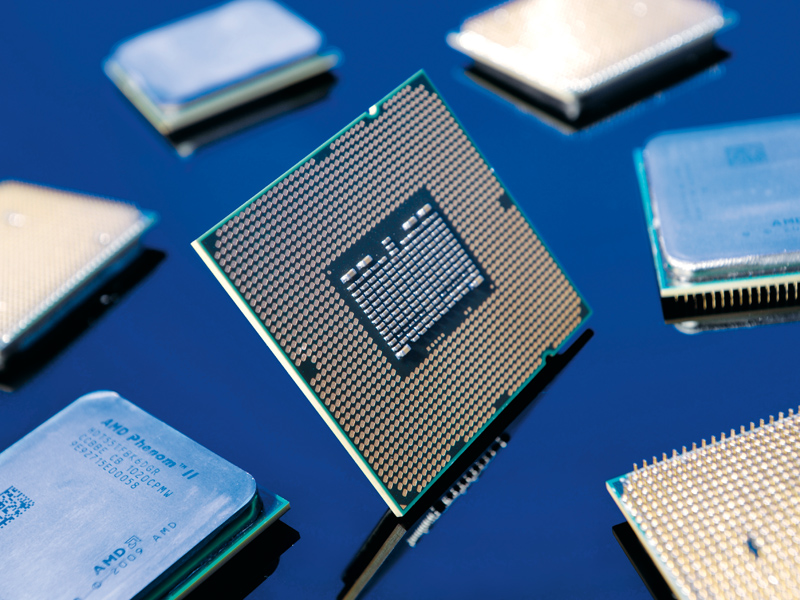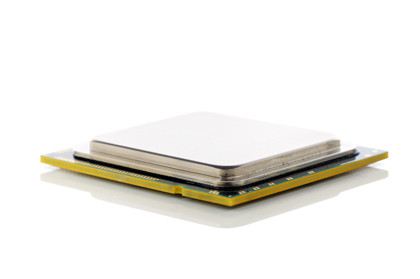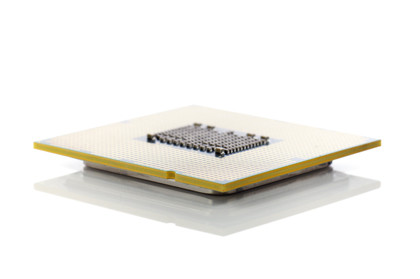
Upgrading your PC's processor isn't the easiest or cheapest way to boost its performance, but it can deliver dramatic results. The right chip can transform a sluggish machine into a powerhouse.
The practicalities of fitting a processor have remained largely unchanged since the early days of PCs, but selecting a new chip isn't so simple. Once it was just a matter of picking the one with the highest GHz rating. Now you've got to keep that in mind, along with an increasingly complex set of other variables.
First, you need to look at the CPU socket on the motherboard to see whether you need an Intel or AMD processor. Next, you need to consider the processor itself. Each manufacturer will have a slew of subtly different technologies, all packaged inside chips with names that tell you little about them.
When you've chosen a chip type, you'll need to weigh up how many processor cores you need. Should you pick fewer faster cores or go for more cores that run at a comparatively slow speed? Then there are nuances like automatic turbo modes and hypertheading to consider.
Finally, you need to think about the interplay between your CPU and graphics processing unit.
Lets consider one factor in detail: the number of cores. As perverse as it sounds, more cores don't necessarily mean more speed. Speed is largely determined by the applications you're running, and how they use those cores.
Thankfully, many video editing suites and games are now written to use multiple cores simultaneously. The same applications (including Photoshop, Adobe Premiere and HD video players) can take advantage of GPU acceleration. You therefore need to think about your system holistically, considering your requirements.
Sign up for breaking news, reviews, opinion, top tech deals, and more.
Video-editing professionals, for example, might opt for a dual-core MacBook Pro, with a GeForce chip for encoding HD streams with Final Cut Pro. This would do a better job than a PC with a quad-core CPU and a non-programmable graphics card.
There are other factors to consider, too. For example, Intel's new Sandy Bridge CPUs have an astonishingly good Quick Sync video encoding engine, which is often better than GPU acceleration.
We'll guide you through the business of picking the best chip. It might not be an easy decision, but with the array of new silicon, you're sure to find one that's a good fit for you and your system.
The great processor war heats up
The battle between AMD and Intel has been raging for decades, but it feels like Intel may have gained the upper hand. Even the billion-dollar recall of its new 6 Series motherboards failed to upset the launch of its Sandy Bridge processors - the week the recall was announced, Intel's share price actually rose. Such is the market's confidence in Intel's silicon.
AMD has been trailing in raw performance since the launch of Intel's Core 2, which blew the Athlon 64 out of the water. Throwing cores at the problem hasn't helped either - six-core Phenom II chips can't keep pace with their Intel quad-core rivals.
Don't write AMD off just yet, though. This summer we're expecting to see AMD processors based on a completely new design, currently called Bulldozer, which could pose a real threat to Intel's dominance.
Bulldozer's design looks very advanced and efficient. AMD has yet to confirm which chips it's planning to launch, but the internal structure is very different from what's gone before.
The basic unit within Bulldozer is a dual-core module, which can share resources across its two execution engines or divide them up for increased parallelism. The first Bulldozer chips, codenamed Zambezi, will be come in four, six or eight-core variants, which suggests they'll build on AMD's current strategy of offering more cores for less than Intel.
The biggest problem AMD faces will be branding. It's already begun its Fusion project, which - like Intel's Sandy Bridge chips - integrates a graphics core onto the same die as a CPU. Bulldozer, however, won't be part of the Fusion line-up for over a year.
AMD's first Fusion processors have been built around the low-end Bobcat core, which is aimed at netbooks and thin and light laptops - somewhere above an Atom, but below a Core i3.
The first Fusion chips for desktop use will be based on Phenom II, and will launch around the same time as Bulldozer. That gives AMD the problem of trying to communicate the relative strengths and weaknesses of many different CPU types at the same time.
By comparison, Intel has already begun retiring many of its Nehalem-based Core processors, giving it two main platforms - Atom and Core - which are relatively easy to understand. Pentium and Celeron will continue to exist as value brands, but even these will use Sandy Bridge designs and the new socket 1155 motherboards.
Only at Intel's extreme high end, where six-core CPUs based on the older Gulftown design are still being released, is there any inconsistency - and these are already starting to look irrelevant in the wake of Sandy Bridge's performance (see the 980x review).
By the time the new Bulldozer Fusion chips arrive, Intel should have completed its plans to migrate Sandy Bridge onto a 22nm process. With that sort of performance increase and cost reduction, AMD could be left trailing behind.
12 CPU choices
Intel processors: The high end

Intel Core i7 980X
Performance
Price: £750
Want the finest CPU money can buy? Look no further than the Intel Core i7 980X. It's the undisputed world heavyweight champ among chips. Just remember you'll need a lot of it. The money, that is.
But what a processor you get in return. The Core I7 980X is, of course, a six-core beast. But this is six-cores Intel style, so that's two threads per core and a dozen of those little green graphs when you fire up task manager. That's unparalleled, er, parallelism in a PC processor.
In that context, even AMD's Phenom II X6 1090T Black Edition looks rather ordinary. It may have six cores. But each is single-threaded only. Moreover, AMD's underlying CPU architecture is pretty ancient while the Intel Core i7 980X is literally the latest thing, right down to is impossibly tiny 32nm underpinnings. What it isn't however, is unique. The recently released Core i7 970 is largely the same six-core, 12-thread processor at a slightly less offensive price point.
Read the full Intel Core i7 980X review
Verdict: 4.5/5
Intel Core i5 2500K
Budget
Price: £190
Ready or not, here they come. Intel is rolling out a thoroughly overhauled range of PC processors based on its new Sandy Bridge microarchitecture. Our first taste of the new chips comes in the form of the Intel Core i5-2500K and Intel Core i7-2600K desktop CPUs.
Thanks to the baffling array of chips, sockets and brands, we've barely got to grips with Intel's existing CPU range. Certainly Intel's main rival, AMD, has no answer in outright performance terms to the chips Intel already offers, but the relentless march of technology must go on.
So, ignore the familiar Core i5 and Core i7 branding. These are all new processors and they're ready to roll.
As it happens, Intel could actually do with more powerful and, crucially, more power efficient processors for laptop PCs. Deep down, that's what Sandy Bridge is really about. However, as we'll learn, Sandy Bridge has a lot to offer for the desktop, too, including exciting new features such as a hardware video transcoding engine and much-improved integrated graphics.
Read the full Intel Core i5 2500K review
Verdict: 4.5/5
Intel Core i7 2600S
All Rounder
Price: £235
Another day another new Sandy Bridge CPU, and another new suffix to get your head around. This time it's the Intel Core i7 2600S.
Many people have heard of the Core i7 2600K by now, the unlocked overclocking demon that was part of the original Sandy Bridge launch, but the Core i7 2600S you may not have heard of.
It's also pretty well known that if a second-gen Core CPU doesn't have a K at the end of the model number, its pretty much game over for any sort of serious overclocking. So what does the S stand for, and does it mean even more features turned off?
Well no, the S models represent more low power units, but just not as low powered as the T models. So instead of the 95W of a standard 2600 part, they have a TDP of 65W, as compared to the 45W of the T series.
Apart from the low power rating, the Intel Core i7 2600S still retains all the familiar features of the 2600 family: four cores, eight threads and 8MB of Smart Cache. But as with all the S class chips, it's clocked slower than the rest of the their family.
In the case of the Core i7 2600S, this means it runs at 2.8GHz compared to the 3.4GHz (3.8GHz max Turbo) of the i7 2600 and Intel Core i7 2600K.
Read the full Intel Core i7 2600S review
Verdict: 4/5
Intel processors: The mid-range

Intel Core i5 2300
Performance
Price: £150
This is the lowest specced of Intel's new Core i5 series, but it only costs a little less than the faster 2500. That said, there's not a lot of difference in performance either unless you're planning to overclock, so you may as well opt for this slightly cheaper model and save a little cash.
This quad-core Sandy Bridge CPU has a base clockspeed of 2.8GHz, and can accelerate to 3.1GHz under Turbo mode. Like all i5s, it doesn't have Hyperthreading enabled, but it's still more than a match for all but the very fastest of AMD's six-core Phenom IIs in everything except demanding video encoding applications.
Even though it's Intel's least expensive quad-core, the i5 2300 still isn't cheap. Factor in the price of an H67 motherboard, and it highlights a significant problem for a lot of the current Core line-up: there are a lot of three, four and even six-core AMD processors available for less, and if you're on a really tight budget there's every reason to be swayed by them.
Verdict: 4/5
Pentium G6950
Budget
Price: £75
This the cheapest CPU currently available from Intel, costing just £75, but it still offers an impressive balance of performance and value.
Its low price can be attributed to the fact that it's not a new chip. Launched last year and based on the Clarkdale architecture, the Pentium Dual Core G6950 is almost identical to the outgoing Core i3s in that it requires a Socket 1156 motherboard, has an on-board graphics accelerator (albeit a low power one) and is designed around the superb Nehalem core.
With a base clock of 2.8GHz and no Turbo Boost or Hyperthreading abilities, the G6950 can't keep up with its Core i3 brethren, but it's proved itself to be a top overclocker in the past.
Ultimately though, if you're looking at spending less than £100 on a new CPU, you'll probably be more attracted to the even cheaper Athlon IIs. They aren't as fast as the G6950, but they'll get the job done perfectly well for less.
Verdict: 3/5
Intel Core i3 2100
All Rounder
Price: £108
After all the Sandy Bridge goodness without the quad-core price-tag? Then the dual-core Intel Core i3 2100 might well be up your street.
While the high-end unlocked Sandy Bridge CPUs, the Intel Core i7 2600K and Intel Core i5 2500K were rightfully taking all the plaudits for being overclocking monsters, the 2600K especially, not many people were looking at the other end of the food chain.
That is to say in the value end of the market where the lowly Intel Core i3 2100 is to be found. As with all the current Sandy Bridge processors, it's built on the 32nm process and manages to pack 504 million transistors into its die.
The Core i3 2100 is clocked at 3.1GHz with 3MB of L3 cache, which sounds like it should be a fairly blazing chip. However it has no Turbo Boost and is totally locked down, so there's no overclocking fun available on the processing side.
This is a pity, because some of the best overclockable Intel chips in the past have come from this segment of the market.
You may not be able to overclock the CPU core but you can though do a smidgen of tinkering to the HD2000 graphics core integrated into this second generation Core CPU.
Read the full Intel Core i3 2100 review
Verdict: 3/5